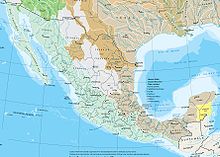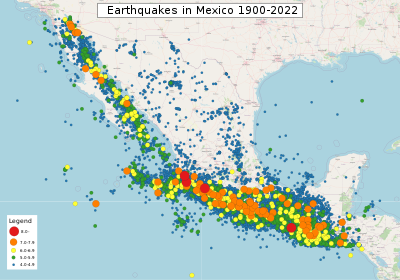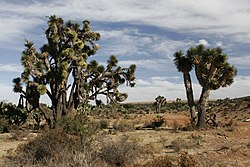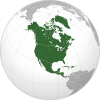Geography of Mexico
Laguna Salada -10 m | |
| Longest river | Rio Grande 3,108 km |
|---|---|
| Largest lake | Lake Chapala 1,100 km2 (420 sq mi) |
| Exclusive economic zone | 3,269,386 km2 (1,262,317 sq mi) |
The geography of Mexico describes the geographic features of
Almost all of Mexico is on the
As well as
Mexico has a 9,330-kilometer coastline, of which 7,338 kilometers face the Pacific Ocean and the Gulf of California, and the remaining 2,805 kilometers front the Gulf of Mexico and the Caribbean Sea. Mexico's
Physical features
Mountain ranges and elevations

Beginning approximately 50 kilometres (31 mi) from the United States border, the

The Sierra Madre Oriental mountain range starts at the Big Bend region of the border with the U.S. state of Texas and continues 1,350 kilometres (840 mi) until reaching Cofre de Perote, one of the major peaks of the Cordillera Neovolcánica. As is the case with the Sierra Madre Occidental, the Sierra Madre Oriental comes progressively closer to the coastline as it approaches its southern terminus, reaching to within 75 kilometres (47 mi) of the Gulf of Mexico. The northeast coastal plain extends from the eastern slope of the Sierra Madre Oriental to the Gulf of Mexico. The median elevation of the Sierra Madre Oriental is 2,200 metres (7,200 ft), with some peaks at 3,000 metres (9,800 ft).
The

One other significant mountain range, the
Several important mountain ranges dominate the landscape of southern and southeastern Mexico. The Sierra Madre del Sur extends 1,200 kilometers along Mexico's southern coast from the southwestern part of the Cordillera Neovolcánica to the nearly flat isthmus of Tehuantepec. Mountains in this range average 2,000 meters in elevation. The range averages 100 kilometers wide, but widens to 150 kilometers in the state of Oaxaca. The narrow southwest coastal plain extends from the Sierra Madre del Sur to the Pacific Ocean. The Sierra Madre de Oaxaca begins at Pico de Orizaba and extends in a southeasterly direction for 300 kilometers until reaching the isthmus of Tehuantepec. Peaks in the Sierra Madre de Oaxaca average 2,500 meters in elevation, with some peaks exceeding 3,000 meters. South of the isthmus of Tehuantepec, the Sierra Madre de Chiapas runs 280 kilometers along the Pacific Coast from the Oaxaca-Chiapas border to Mexico's border with Guatemala. Although average elevation is only 1,500 meters, one peak—Volcán de Tacuma—exceeds 4,000 meters in elevation. Finally, the Meseta Central de Chiapas extends 250 kilometers through the central part of Chiapas to Guatemala. The average height of peaks of the Meseta Central de Chiapas is 2,000 meters. The Chiapas central valley separates the Meseta Central de Chiapas and the Sierra Madre de Chiapas.
Rivers and other bodies of water

Mexico has nearly 150 rivers, two-thirds of which empty into the Pacific Ocean and the remainder of which flow into the
Seismic activity

Situated atop three of the large tectonic plates that constitute the Earth's surface, Mexico is one of the most seismologically active regions on Earth.[8] The motion of these plates causes earthquakes and volcanic activity.
Most of the Mexican landmass rests on the westward moving North American plate. The Pacific Ocean floor off southern Mexico, however, is being carried northeast by the underlying motion of the Cocos Plate. Ocean floor material is relatively dense; when it strikes the lighter granite of the Mexican landmass, the ocean floor is forced under the landmass, creating the deep Middle America Trench that lies off Mexico's southern coast. The westward moving land atop the North American plate is slowed and crumpled where it meets the Cocos plate, creating the mountain ranges of southern Mexico. The subduction of the Cocos plate accounts for the frequency of earthquakes near Mexico's southern coast. As the rocks constituting the ocean floor are forced down, they melt, and the molten material is forced up through weaknesses in the surface rock, creating the volcanoes in the Cordillera Neovolcánica across central Mexico.

Areas of Mexico's coastline on the
Mexico has a
Climate

The Tropic of Cancer effectively divides the country into temperate and tropical zones. Land north of the twenty-fourth parallel experiences cooler temperatures during the winter months. South of the twenty-fourth parallel, temperatures are fairly constant year round and vary solely as a function of elevation.
Areas south of the twentieth-fourth parallel with elevations up to 1,000 meters (3,281 ft) (the southern parts of both coastal plains as well as the Yucatán Peninsula), have a yearly median temperature between 24 and 28 °C (75.2 and 82.4 °F). Temperatures here remain high throughout the year, with only a 5 °C (9 °F) difference between winter and summer median temperatures. Although low-lying areas north of the twentieth-fourth parallel are hot and humid during the summer, they generally have lower yearly temperature averages (from 20 to 24 °C or 68.0 to 75.2 °F) because of more moderate conditions during the winter.


Between 1,000 and 2,000 meters (3,281 and 6,562 ft), one encounters yearly average temperatures between 16 and 20 °C (60.8 and 68.0 °F). Towns and cities at this elevation south of the twenty-fourth parallel have relatively constant, pleasant temperatures throughout the year, whereas more northerly locations experience sizeable seasonal variations. Above 2,000 meters (6,562 ft), temperatures drop as low as an average yearly range between 8 and 12 °C (46.4 and 53.6 °F) in the
Mexico lies squarely within the
Climate change
Environmental conditions

Mexico faces significant environmental challenges damaging nearly all sections of the country. Vast expanses of southern and southeastern tropical forests have been denuded due to mineral resource extraction,

Soil destruction is particularly pronounced in the north and northwest, with more than 60% of land considered in a total or accelerated state of erosion. Fragile because of its semiarid and arid character, the soil of the region has become increasingly damaged through excessive cattle-raising and irrigation with waters containing high levels of salinity. The result is a mounting problem of desertification throughout the region.[17]
Mexico's vast coastline faces a different, but no less difficult, series of environmental problems. For example, inadequately regulated petroleum exploitation in the
Beginning in the mid-1980s, the government enacted numerous antipollution policies in Mexico City with varied degrees of success. Measures such as vehicle emissions inspections, the introduction of unleaded gasoline, and the installation of catalytic converters on new vehicles helped reduce pollution generated by trucks and buses. In contrast, one of the government's most prominent actions, the No Driving Day program, may have inadvertently contributed to higher pollution levels. Under the program, metropolitan area residents were prohibited from driving their vehicles one day each work week based on the last number of their license plate. However, those with the resources to do so purchased additional automobiles to use on the day their principal vehicle was prohibited from driving, thus adding to the region's vehicle stock. Thermal inversions reached such dangerous levels at various times in the mid-1990s that the government declared pollution emergencies, necessitating sharp temporary cutbacks in vehicle use and industrial production.
Mexico had a 2018 Forest Landscape Integrity Index mean score of 6.82/10, ranking it 63rd globally out of 172 countries.[20]
General indicators

Climate: varies from tropical to desert.
Terrain: high, rugged mountains; low coastal plains; high plateaus; desert.
Elevation extremes:
- lowest point: Laguna Salada-10 m
- highest point: Pico de Orizaba volcano 5,700 m
Natural resources:
Land use:
- arable land: 12.98%
- permanent crops: 1.36%
- other: 85.66% (2011)
Irrigated land: 64,600 km2 (2009)
Total renewable water resources: 457.2 km3
Natural hazards:
volcanism: volcanic activity in the central-southern part of the country; the volcanoes in
Environment – current issues: Natural fresh water resources scarce and polluted in north, inaccessible and poor quality in center and extreme southeast; raw sewage and industrial effluents polluting rivers in urban areas;
Environment – international agreements: Party to:
See also
- 4000 meter peaks of Mexico
- Geology of North America
- List of Ultras of Mexico
- Mountain peaks of Mexico
References
- ^ Francaviglia, Richard V. "Geography and climate", U.S. Mexican War, 1846–1848. March 14, 2006: PBS / KERA
- ^ Mexico The American Heritage Reference Collection Archived 2007-02-24 at the Wayback Machine, et al.
- ^ Mexico Archived 2007-06-20 at the Wayback Machine The Columbia Encyclopedia Archived February 2, 2007, at the Wayback Machine
- ^ "Mexico Country Specific Information Archived December 16, 2010, at the Wayback Machine." United States Department of State. Retrieved on March 22, 2012.
- ^ Nord-Amèrica, in Gran Enciclopèdia Catalana
- ^ Robert J. McCarthy, Executive Authority, Adaptive Treaty Interpretation, and the International Boundary and Water Commission, U.S.-Mexico, 14-2 U. Denv. Water L. Rev. 197(Spring 2011) (also available for free download at https://ssrn.com/abstract=1839903).
- ^ "Mexico - Topography and Drainage". countrystudies.us. Retrieved 22 March 2018.
- ^ Rhea, Harley M. Benz, Matthew Herman, Arthur C. Tarr, Gavin P. Hayes, Kevin P. Furlong, Antonio Villaseñor, Richard L. Dart, Susan. "USGS Open-File Report 2010-1083-F: Seismicity of the Earth 1900–2010 Mexico and Vicinity". pubs.usgs.gov. Retrieved 22 March 2018.
{{cite web}}: CS1 maint: multiple names: authors list (link) - ^ Godoy, Emilio (14 Dec 2017). "Climate Change Threatens Mexican Agriculture - Mexico". ReliefWeb. Retrieved 2019-09-28.
- ^ "Climate Change and Migration in Mexico: A Report Launch". Wilson Center. 2013-02-15. Retrieved 2019-09-28.
- ^ Wirtz, Nic (2017-10-16). "Climate change and migration in Mexico: Fifth in our series". Global Americans. Retrieved 2019-09-28.
- ^ How climate change is affecting Mexico
- ^ "How Is Climate Change Affecting Mexico?". Climate Reality. February 15, 2018. Retrieved 2019-09-28.
- ^ Grillo, Ioan (2015-06-06). "Climate change is making Mexico City unbreathable". Salon. Retrieved 2019-09-28.
- PMID 30509982.
- ^ Hill, David (17 May 2014). "Canadian mining doing serious environmental harm, the IACHR is told". The Guardian. Retrieved 20 August 2019.
- ^ a b c "Mexico - Environmental Conditions". countrystudies.us. Retrieved 2021-03-08.
- S2CID 154242750.
- ^ S2CID 157461751.
- PMID 33293507.
 This article incorporates text from this source, which is in the public domain. Mexico: A Country Study. Federal Research Division.
This article incorporates text from this source, which is in the public domain. Mexico: A Country Study. Federal Research Division. This article incorporates public domain material from The World Factbook. CIA.
This article incorporates public domain material from The World Factbook. CIA.


